Regency Fireplace Products Stove C33-LP3 User manual
- Category
- Fireplaces
- Type
- User manual

WARNING:
If the information in these instructions are not followed ex-
actly, a fi re or explosion may result causing property damage,
personal injury or loss of life.
FOR YOUR SAFETY
Do not store or use gasoline or other fl ammable vapors and
liquids in the vicinity of this or any other appliance.
Installation and service must be performed by a qualifi ed
installer, service agency or the gas supplier.
FOR YOUR SAFETY
What to do if you smell gas:
Do not try to light any appliance
Do not touch any electrical switch:
do not use any phone in your build-
ing.
Immediately call your gas supplier
from a neighbour's phone. Follow
the gas supplier's instructions.
If you cannot reach your gas sup-
plier, call the fi re department.
FPI FIREPLACE PRODUCTS INTERNATIONAL LTD. 6988 Venture St., Delta, BC Canada, V4G 1H4
918-511
MODELS: C33-NG3 Natural Gas C33-LP3 Propane
C33 Classic Freestanding Gas Stove
Classic C33 model shown above features
optional gold plated door and gold legs.
07/17/06
Owners &
Installation Manual
Tested by:
Installer: Please complete the details on the back cover
and leave this manual with the homeowner.
Homeowner: Please keep these instructions for future reference.
www.regency-fi re.com

2
Regency
®
CLASSIC C33-3 Freestanding Gas Stove
To the New Owner:
Congratulations! You are the owner of a state-of-the-art Gas Stove by Fireplace Products International
Ltd. The Regency
®
Gas Series of hand crafted appliances has been designed to provide you with all the
warmth and charm of a woodstove, at the fl ick of a switch. The models C33-NG3 and C33-LP3 have been
approved by Warnock Hersey for both safety and effi ciency. As it also bears our own mark, it promises to
provide you with economy, comfort and security for many trouble free years to follow. Please take a mo-
ment now to acquaint yourself with these instructions and the many features of your CLASSIC Freestanding
Gas Stove.

Regency
®
CLASSIC C33-3 Freestanding Gas Stove 3
TABLE OF CONTENTS
SAFETY LABEL
Serial No. Decal ............................................................4
REQUIREMENTS
MA Code - CO Detector
(for state of Massachusetts only) ..................................5
INSTALLATION
Before You Start ............................................................6
Important Message ........................................................6
General Safety Information ...........................................6
Installation Checklist ......................................................6
Clearances to Combustibles .........................................7
Optional Fan Installation ................................................7
Pedestal Assembly ........................................................8
Leg and Bottom Shield Assembly ..................................9
Optional Outside Air ......................................................9
Draft Hood .....................................................................9
Venting ..........................................................................9
Gas Connection ...........................................................10
System Data ................................................................10
High Elevation .............................................................10
Gas Pipe Pressure Testing ..........................................10
Installation of the DC Sparker ..................................... 11
Test for Flue Spillage ...................................................12
Log Set Installation ......................................................12
Safety Latch ................................................................13
Door Handle ................................................................13
Remote Control Installation .........................................13
Remote Wall Switch ....................................................13
Wall Thermostat Installation ........................................13
Final Check .................................................................13
Wiring Diagrams ..........................................................14
Normal Operating Sounds of Gas Appliances .............15
OPERATING INSTRUCTIONS
Operating Instructions .................................................16
Lighting Procedure ......................................................16
Shutdown Procedure ...................................................16
Maintenance Instructions ............................................16
Copy of the Lighting Plate instructions .......................17
MAINTENANCE
General Vent Maintenance ..........................................18
Thermopile / Thermocouple .........................................18
Aeration Adjustment ....................................................18
Pilot Adjustment ...........................................................18
Log Replacement ........................................................19
Gold-plated Doors .......................................................19
Glass Replacement .....................................................19
Removing Valve Assembly ..........................................20
Installing Valve Assembly ............................................20
PARTS LIST
Main Assembly ............................................................21
Burner & Logs .............................................................22
Base Options ...............................................................23
WARRANTY
Warranty ......................................................................27

4
Regency
®
CLASSIC C33-3 Freestanding Gas Stove
This is a copy of the label that accompanies each
CLASSIC Freestanding Gas Stove - Natural
Gas and Propane. We have printed a copy of
the contents here for your review. The safety
label is located on the back panel.
NOTE: Regency
®
units are constantly being
improved. Check the label on the unit and if
there is a difference, the label on the unit is the
correct one.
SAFETY LABEL
For the State of Massachusetts, installation
and repair must be done by a plumber or
gasfi tter licensed in the Commonwealth of
Massachusetts.
For the State of Massachusetts, fl exible
connectors shall not exceed 36 inches in
length.
For the State of Massachusetts, the appli-
ances individual manual shut-off must be a
t-handle type valve.
The State of Massachusetts requires the
installation of a carbon monoxide alarm in
accordance with NFPA 720 and a CO alarm
with battery back up in the same room where
the gas appliance is installed.

Regency
®
CLASSIC C33-3 Freestanding Gas Stove 5
REQUIREMENTS
5.08: Modifications to NFPA-54, Chapter 10
(2) Revise 10.8.3 by adding the following additional requirements:
(a) For all side wall horizontally vented gas fueled equipment installed in every dwelling, building or structure used in whole or in part for
residential purposes, including those owned or operated by the Commonwealth and where the side wall exhaust vent termination is less than
seven (7) feet above finished grade in the area of the venting, including but not limited to decks and porches, the following requirements shall
be satisfied:
1. INSTALLATION OF CARBON MONOXIDE DETECTORS. At the time of installation of the side wall horizontal vented gas fueled
equipment, the installing plumber or gasfitter shall observe that a hard wired carbon monoxide detector with an alarm and battery back-up is
installed on the floor level where the gas equipment is to be installed. In addition, the installing plumber or gasfitter shall observe that a battery
operated or hard wired carbon monoxide detector with an alarm is installed on each additional level of the dwelling, building or structure
served by the side wall horizontal vented gas fueled equipment. It shall be the responsibility of the property owner to secure the services of
qualified licensed professionals for the installation of hard wired carbon monoxide detectors
a. In the event that the side wall horizontally vented gas fueled equipment is installed in a crawl space or an attic, the hard wired carbon
monoxide detector with alarm and battery back-up may be installed on the next adjacent floor level.
b. In the event that the requirements of this subdivision can not be met at the time of completion of installation, the owner shall have a period of
thirty (30) days to comply with the above requirements; provided, however, that during said thirty (30) day period, a battery operated carbon
monoxide detector with an alarm shall be installed.
2. APPROVED CARBON MONOXIDE DETECTORS. Each carbon monoxide detector as required in accordance with the above provisions
shall comply with NFPA 720 and be ANSI/UL 2034 listed and IAS certified.
3. SIGNAGE. A metal or plastic identification plate shall be permanently mounted to the exterior of the building at a minimum height of eight
(8) feet above grade directly in line with the exhaust vent terminal for the horizontally vented gas fueled heating appliance or equipment. The
sign shall read, in print size no less than one-half (1/2) inch in size, "GAS VENT DIRECTLY BELOW. KEEP CLEAR OF ALL
OBSTRUCTIONS".
4. INSPECTION. The state or local gas inspector of the side wall horizontally vented gas fueled equipment shall not approve the installation
unless, upon inspection, the inspector observes carbon monoxide detectors and signage installed in accordance with the provisions of 248 CMR
5.08(2)(a)1 through 4.
(b) EXEMPTIONS: The following equipment is exempt from 248 CMR 5.08(2)(a)1 through 4:
1. The equipment listed in Chapter 10 entitled "Equipment Not Required To Be Vented" in the most current edition of NFPA 54 as adopted by
the Board; and
2. Product Approved side wall horizontally vented gas fueled equipment installed in a room or structure separate from the dwelling, building or
structure used in whole or in part for residential purposes.
(c) MANUFACTURER REQUIREMENTS - GAS EQUIPMENT VENTING SYSTEM PROVIDED. When the manufacturer of Product
Approved side wall horizontally vented gas equipment provides a venting system design or venting system components with the equipment, the
instructions provided by the manufacturer for installation of the equipment and the venting system shall include:
1. Detailed instructions for the installation of the venting system design or the venting system components; and
2. A complete parts list for the venting system design or venting system.
(d) MANUFACTURER REQUIREMENTS - GAS EQUIPMENT VENTING SYSTEM NOT PROVIDED. When the manufacturer of a
Product Approved side wall horizontally vented gas fueled equipment does not provide the parts for venting the flue gases, but identifies
"special venting systems", the following requirements shall be satisfied by the manufacturer:
1. The referenced "special venting system" instructions shall be included with the appliance or equipment installation instructions; and
2. The "special venting systems" shall be Product Approved by the Board, and the instructions for that system shall include a parts list and
detailed installation instructions.
(e) A copy of all installation instructions for all Product Approved side wall horizontally vented gas fueled equipment, all venting instructions,
all parts lists for venting instructions, and/or all venting design instructions shall remain with the appliance or equipment at the completion of
the installation.
MA Code - CO Detector
(for the State of Massachusetts only)

6
Regency
®
CLASSIC C33-3 Freestanding Gas Stove
INSTALLATION
IMPORTANT MESSAGE
The CLASSIC Freestanding Gas Stove must be
installed in accordance with these instructions.
Carefully read all the instructions in this manual
fi rst. Consult the "authority having jurisdiction" to
determine the need for a permit prior to starting
the installation.
GENERAL SAFETY
INFORMATION
1) The appliance installation must conform
with local codes or, in the absence of local
codes, with the current Canadian or National
Gas Codes, CAN1-B149 or ANSI Z223.1
Installation Codes.
2) The appliance when installed, must be
electrically grounded in accordance with
local codes, or in the absence of local codes
with the current National Electrical Code,
ANSI/NFPA 70 or CSA C22.1 Canadian
Electrical Code.
3) This appliance is Listed for bedroom instal-
lations when used with a Listed Millivolt
Thermostat. Some areas may have further
requirements, check local codes before
installation.
4) This appliance is Listed for Alcove instal-
lations, maintain minimum Alcove clear-
ances as follows, minimum ceiling height
of 65-11/16", minimum width of 48" and a
maximum depth of 36".
5) This unit is not approved for installation into
a mobile home.
6) See general construction and assembly
instructions.
7) This appliance must be connected to a vent
and terminate to the outside of the building
envelope. Never vent to another room or
inside a building.
8) Inspect the venting system annually for
blockage and any signs of deterioration.
9) Any safety glass removed for servicing
must be replaced prior to operating the ap-
pliance.
10) To prevent injury, do not allow anyone who
is unfamiliar with the operation to use the
fi replace.
11) Wear gloves and safety glasses for protec-
tion while doing required maintenance.
12) Under no circumstances should this ap-
pliance be modifi ed. Parts that have to be
removed for servicing should be replaced
prior to operating this appliance.
BEFORE YOU START
Safe installation and operation of this appliance
requires common sense, however, we are
required by the Canadian Safety Standards
and ANSI Standards to make you aware of
the following:
INSTALLATION AND REPAIR
SHOULD BE DONE BY A QUALI-
FIED SERVICE PERSON. THE
APPLIANCE SHOULD BE IN-
SPECTED BEFORE USE AND AT
LEAST ANNUALLY BY A PRO-
FESSIONAL SERVICE PERSON.
MORE FREQUENT CLEANING
MAY BE REQUIRED DUE TO EX-
CESSIVE LINT FROM CARPETING,
BEDDING MATERIAL, ETC. IT IS
IMPERATIVE THAT CONTROL
COMPARTMENTS, BURNERS
AND CIRCULATING AIR PAS-
SAGEWAYS OF THE APPLIANCE
BE KEPT CLEAN.
DUE TO HIGH TEMPERATURES,
THE APPLIANCE SHOULD BE
LOCATED OUT OF TRAFFIC AND
AWAY FROM FURNITURE AND
DRAPERIES.
WARNING: FAILURE TO INSTALL
THIS APPLIANCE CORRECTLY
MAY CAUSE A SERIOUS HOUSE
FIRE AND WILL VOID YOUR WAR-
RANTY.
CHILDREN AND ADULTS SHOULD
BE ALERTED TO THE HAZARDS
OF HIGH SURFACE TEMPERA-
TURES, ESPECIALLY THE FIRE-
PLACE GLASS, AND SHOULD
STAY AWAY TO AVOID BURNS OR
CLOTHING IGNITION.
YOUNG CHILDREN SHOULD BE
CAREFULLY SUPERVISED WHEN
THEY ARE IN THE SAME ROOM
AS THE APPLIANCE.
CLOTHING OR OTHER FLAM-
MABLE MATERIAL SHOULD NOT
BE PLACED ON OR NEAR THE
APPLIANCE.
13) Installation and any repairs to this appliance
should be done by a qualifi ed service person.
A professional service person should be called
to inspect this appliance annually. Make it a
practice to have all of your gas appliances
checked annually.
14) Do not strike the glass door.
15) Under no circumstances should any solid fuels
(wood, paper, cardboard, coal, etc.) be used in
this appliance.
16) The appliance area must be kept clear and
free of combustible materials, (gases and other
fl ammable vapours and liquids).
INSTALLATION
CHECKLIST
1) Locate appliance. Refer to the "Clearance to
Combustible" section.
2) Install Optional Fan. Refer to the "Optional Fan
Installation" section.
3) Assemble stove base - pedestal or legs. Refer
to "Pedestal Assembly" or "Leg and Bottom
Shield Assembly" section.
4) If using outside air. Refer to the "Optional
Outside Air" section.
5) Install venting. Refer to the "Venting" section.
6) Make gas and electrical connections. Refer to
the "Gas Connection" section.
Test the pilot. Must be as per diagram in the
"Pilot Adjustment" section.
7) Test gas pressure. Refer to the "Gas Pipe Pres-
sure Testing" section.
8) Test for fl ue spillage. Refer to the "Test for Fuel
Spillage" section.
9) Install standard and optional features. Refer to
the following sections where applicable:
a. Log Set Installation
b. Remote Control
c. Remote Wall Switch
d. Wall Thermostat
11) Final check. Refer to the "Final Check" sec-
tion.
Before leaving this unit with the customer, the
installer must ensure that the appliance is fi ring cor-
rectly and operation fully explained to customer.
Emissions from burning wood or gas could
contain chemicals known to the State of Cali-
fornia to cause cancer, birth defects or other
reproductive harm.

Regency
®
CLASSIC C33-3 Freestanding Gas Stove 7
Diagram 4
9) Lift the fan assembly in through the pedestal
and up through the cut out as shown in
diagrams 3 and 4.
10) Put the insulation gasket on the back of
the fan. Line up the keyhole slots with the
matching screws and pull back slightly to
lock into place. While holding fan assembly
in place, tighten screws.
Diagram 3
Diagram 2
OPTIONAL FAN
INSTALLATION
Important: Disconnect the power
supply before installation or serv-
icing.
For pedestal unit: To install the fan in an in-
stalled stove-access from front through the
pedestal by following the directions below.
If the stove is not installed - access through
rear and follow steps 4 to 17.
Diagram 1
INSTALLATION
CLEARANCES TO
COMBUSTIBLES
The clearances listed below are MINIMUM
distances. Measure the clearance to both the
appliance and the chimney connector. The far-
thest distance is correct if the two clearances do
not coincide. For example, if the appliance is set
as indicated in one of the diagrams but the back
wall is too close, move the stove until the correct
clearance to the back wall is obtained.
This unit can be installed on a solid combustible
surface like a wood fl oor. This unit can also be
installed directly on carpeting or vinyl when the
bottom pedestal cover plate (provided with the
unit) is installed.
This appliance may be installed only with the
clearances as shown in the situations pictured.
Do not combine clearances from one type of
installation with another in order to achieve
closer clearances. Use the minimum clearances
shown in the diagrams. Alcove installations are
approved, as long as side wall clearances are
maintained.
C33-3 Clearances to Combustibles
A Side Wall to Unit 10" / 250 mm
B Back Wall to Unit 6" / 150 mm
E Side Wall to Unit 1.5" / 38 mm
C33-3 Reference Dimensions
to Flue Centerline
C Back Wall 11-1/2"/ 292 mm
D Side Wall 22" / 559 mm
F Side Wall 13" / 330 mm
Minimum ceiling height is 36" / 914 mm from
This includes:
1) Clocking the appliance to ensure the correct
fi ring rate (rate noted on label) after burning
appliance for 15 minutes.
2) If required, adjusting the primary air to
ensure that the fl ame does not carbon.
First allow the unit to burn for 15-20 min.
to stabilize.
3) Check for proper draft.
CAUTION: Any alteration to the product that
causes sooting or carboning that results
in damage is not the responsibility of the
manufacturer.
For leg unit: remove 7 screws, remove bottom
access panel and install fan assembly and
follow steps 4 to 17.
1) Open pedestal door and remove door cover
plate by removing 4 screws. See diagram
1.
2) Remove valve cover plate by removing 2
screws.
3) Remove wire from piezo ignitor.
4) Screw the four 8-32 x 3/4 screws provided
into the nutserts as shown in diagram 3. Do
not tighten screws.
5) Push all the fan wires through the hole on
the fan assembly. See diagram 2
.
6) Put power cord (shown in diagram 3) through
the hole and pull through to front of unit for
easier installation of ground wire.
7) Place fan assembly partially in door cover
plate hole. See diagram 2.
8) Attach the 2 ground wires (green) to the
ground lug as per diagram 2.
Note:Ground lug is located on the bottom of the
fan assembly. See diagram 2.

8
Regency
®
CLASSIC C33-3 Freestanding Gas Stove
INSTALLATION
PEDESTAL ASSEMBLY
1) For easier assembly, tip the stove on its back
(preferably onto a soft surface to prevent
scratching).
2) Unscrew the 4 bolts in the underside of the
stove. Align the holes in the corners of the
pedestal top with the corresponding holes in
the base of the stove. Use washers which
are supplied with the pedestal as shown in
diagram. Reinstall bolts.
Diagram 1
Wiring Diagram
Wiring
11) Remove the dummy plug from the right side
of the bottom shield or pedestal and install
the supplied fan switch.
12) Attach hot wire from power cord to the ther-
modisc.
13) Slide the thermodisc under the bracket.
16) Pull power wire back and put strain relief
grommet in place as per diagram 4.
17) Reverse steps 3-1 to complete installa-
tion.
Note: The #8 ground lug is a dedicated
ground for mobile home use only.
Only C34 unit is approved for mobile
homes.
Caution: Ensure that wires do
NOT touch hot surfaces.
Fan Removal
1) Disconnect the power to fan.
2) Allow the stove to cool to room tempera-
ture.
3) Open the pedestal door and remove the
screws on the door cover plate. Leg Units:
Remove bottom access panel.
4) Loosen the nutsert screws.
5) Remove Fan Assembly from the key slots
at the fan base. Take the fan out from the
rectangular opening . Diagram 3.
6) Turn the fan around 90 degrees (Pedestal
units only). Diagram 2.
7) Disconnect the green ground wires to the
grounding lug.
8) Disconnect the white wire of the fan from
the power cord.
9) Disconnect red wire and black wire (from
fan to Fan Switch).
10) Take fan out from the stove body. Diagram
14) Connecting wires to the 3 way switch -
a. Connect the red wire from the fan to the
top of the 3 way switch.
b. Connect black wire from fan to the bottom
of the 3 way switch.
c. Connect white jumper wire to middle of
the three way switch. See wiring diagram
below.
15) Connect white wire from fan motor to neutral
on the power cord.
View from Bottom of Stove
3) Hook up wires to Burner ON/OFF switch
and valve assembly (be careful not to pinch
wires). See Diagram 1.
4) Push the Regency
®
logo into the two holes
in the front bottom left corner of the pedestal
cover plate.
Note: Any paint touch up should be done
prior to placing logo on pedestal.

Regency
®
CLASSIC C33-3 Freestanding Gas Stove 9
VENTING
This heater is a vented appliance and must be
connected to a chimney/fl ue in accordance with
installation codes.
Note: The rear cover plate is only attached
when outside air is being used. Do
not install it when using room air for
combustion.
For your safety this heater is equipped with a
vent safety switch. This thermally actuated switch
is located within the draft hood and will detect
either a blocked chimney or backdraft condition
where the chimney fl ow has reversed and will
react by shutting off the gas supply.
Note: The spill switch is manually resettable
and comes from the factory in the
open position. Before trying to start
up the unit, make sure the red button
on the spill switch is pushed in.
Venting Requirements
Four inch diameter vent is required. B-Vent,
Class A or Masonry with a liner are all acceptable.
Follow all venting manufacturer’s requirements
and local building codes. For altitudes above
2000 ft. we recommend that a minimum fl ue
height of 12 ft. is used.
Note: Proper sizing of gas vents is critical
to proper operation of all gas stoves
and fi replaces. Ensure that proper
sizing tables or vent manufacturers
instructions are followed.
OPTIONAL
OUTSIDE AIR
If needed, outside air for combustion can be
brought in either through the bottom of the ped-
estal or through the rear plate of the pedestal.
The pedestal cover plate must be installed when
using outside combustion air. Loosen the 4
screws on the rear of the pedestal and slide the
cover plate over them. Slide the plate to the left
to center it and tighten down the 4 screws.
Outside Air Through
Pedestal Bottom
Once you have properly marked the position
of your unit as outlined in "General Informa-
tion" and "Clearances to Combustibles", cut a
minimum 3 inch diameter hole though the fl oor
directly under your pedestal base to the outside.
Pipe fresh air into the pedestal area by using a
minimum 3" duct pipe with a mesh grill at the
outside termination.
Note: Blanking plate combustion air hole is
4" diameter.
IMPORTANT
Read all instructions carefully before starting
the installation. Failure to follow these instruc-
tions may create a fi re or other safety hazard,
and will void the warranty. Be sure to check the
venting and clearance to combustible require-
ments. Consult your local building codes before
beginning installation.
Rear View
Side View
DRAFT HOOD
The heater has a draft hood built into its back.
It must not be altered or obstructed, and the
unit must be installed so that the draft hood is
in the same atmospheric pressure zone as the
combustion air inlet to the burner.
LEG AND BOTTOM
SHIELD ASSEMBLY
These instructions apply to the steel leg, painted
cast leg and the gold plated cast leg. It will be
easier to attach the legs to the stove if it is
tipped on its back (preferably on a soft surface
to prevent scratching).
1) Remove the 4 bolts in the underside of the
base and discard.
2) Put the bottom shield up against the bottom
of the stove and loosely install the four sup-
plied bolts and washers into the threaded
holes in the four corners of the bottom the
unit. Once the bolts are started, slip the leg
under the washer and tighten the bolts.
3) Hook up wires to Burner ON/OFF switch and
valve assembly as per pedestal assembly
diagram (diagram 1).
4) Level the stove by adjusting the levelling
bolts in the bottom of each leg.
INSTALLATION
Outside Air Through
Pedestal Rear
Remove the blanking plate from the rear of the
pedestal cover plate and bend the two tabs out
90 degrees. Pipe fresh air into the pedestal area
by using a minimum 3" duct pipe with a mesh
grill at the outside termination. Attach the pipe
to the tabs with screws.
Note: The hole in the rear pedestal cover
plate is 4" diameter.

10
Regency
®
CLASSIC C33-3 Freestanding Gas Stove
HIGH ELEVATION
This unit is approved in Canada for altitude 0
to 4500 ft. (CAN1 2.17-M90) with the orifi ce
supplied.
GAS PIPE
PRESSURE TESTING
The appliance must be isolated from the gas
supply piping system by closing its individual
manual shut-off valve during any pressure
testing of the gas supply piping system at test
pressures equal to or less than 1/2 psig. (3.45
kPa). Disconnect piping from valve at pressures
over 1/2 psig (14" w.c.).
The manifold pressure is controlled by a regulator
built into the gas control, and should be checked
at the pressure test point.
Note: To properly check gas pressure, both
inlet and manifold pressures should
be checked using the valve pressure
ports on the valve.
1) Make sure the valve is in the "OFF" posi-
tion.
2) Loosen the "IN" and/or "OUT" pressure
tap(s), turning counterclockwise with a
1/8" wide fl at screwdriver.
3) Attach manometer to "IN" and/or "OUT"
pressure tap(s) using a 5/16" ID hose.
4) Light the pilot and turn the valve to "ON"
position.
5) The pressure check should be carried out
with the unit burning and the setting should
be within the limits specifi ed on the safety
label.
6) When fi nished reading manometer, turn
off the gas valve, disconnect the hose and
tighten the screw (clockwise) with a 1/8" fl at
screwdriver. Screw should be snug, but do
not over tighten.
GAS CONNECTION
The gas connection is a 3/8" NPT rigid pipe.
The gas line can be rigid pipe or to make in-
stallation easier, use a listed fl exible connector
and/or copper pipe if allowed by local codes.
For minimum and maximum supply pressure
see the System Data table below.
Note: During any pressure testing of the
gas supply piping system that ex-
ceeds test pressures of 1/2 psig, this
appliance and its individual shut-off
valve must be disconnected from
the piping system. If test pressures
equal to or less than 1/2 psig are used
then this appliance must be isolated
from the piping system by closing
its individual manual shut-off valve
during the testing.
Output capacity:
The effi ciency rating of the appliance is a
product thermal effi ciency rating determined
under continuous operating conditions and
was determined independently of any installed
system.
INSTALLATION
Installing into Existing
Woodstove Flue System
1) Clean existing chimney system.
2) Install stove pipe adapter
3) Install any reducers that may be needed to
fi t 6" fl ue pipe adapter.
4) Run 4" fl ex liner into existing chimney.
5) Slip liner through 6" fl ue pipe and hook up
to fl ue collar with screws.
Note: For ease of in-
stallation, use a
slip section when
installing
with a ver-
tical flue
pipe.
SYSTEM DATA
(For 0 to 2,000 feet altitude)
Orifi ce Sizes:
Burner Natural Gas #36
Burner Propane #52
Max. Input Rating
Natural Gas 33,000 Btu/h
Propane 33,000 Btu/h
Min. Input Rating
Natural Gas 17,000 Btu/h
Propane 17,000 Btu/h
Output Capacity with blower Off
Natural Gas 23,200 Btu/h
Propane 23,100 Btu/h
Output Capacity with blower On
Natural Gas 24,600 Btu/h
Propane 24,420 Btu/h
Supply Pressure
Natural Gas min. 5.0" w.c
max. 8.0" w.c.
Propane min. 12.0" w.c.
max. 13.0" w.c.
Manifold Pressure High
Natural Gas 3.8" +/- 0.2" w.c.
Propane 11" +/- 0.2" w.c.
Manifold Pressure Low
Natural Gas 1.1" +/- 0.2" w.c.
Propane 2.9" +/- 0.2" w.c.
Electrical: 120V, 1.13A, 60 Hz.
Circulation Fan: (optional) 2 speed
75/125 CFM.
Log Set: Ceramic fi ber, 4 per set.
SYSTEM DATA
(For 2,000 to 4,500 feet altitude)
Orifi ce Sizes:
Burner Natural Gas #38
Max. Input Rating
Natural Gas 29,000 Btu/h
Min. Input Rating
Natural Gas 15,300 Btu/h
Output Capacity with blower Off
Natural Gas 20,400 Btu/h
Output Capacity with blower On
Natural Gas 21,600 Btu/h

Regency
®
CLASSIC C33-3 Freestanding Gas Stove 11
VALVE
DESCRIPTION
1) Gas on/off knob
2) Manual high/low adjustment
3) Pilot Adjustment
4) Thermocouple Connection
5) Main Operator
6) Outlet Pressure Tap
7) Inlet Pressure Tap
8) Pilot Outlet
9) Main Gas Outlet
10) Flange Securing Screw Holes
11) Alternative TC Connection Point
12) Thermoelectric Unit
13) Additional Valve Mounting Hole
INSTALLATION OF THE
DC SPARKER
1) Attach the ground wire to the grounding
stub.
After
Before
4) Loop the wires
through the heat
shield.
5) Install the plastic bushing over the outside of
the hole to protect the wires from the sharp
edges.
6a) Attach the ground wire to the DC spark
mounting bracket.
6b) Next, attach the DC sparker generator wires
to the DC sparker.
ground wire
DC spark generating wires
Piezo ignition wires
2) Loop the 2 DC Spark generating wires as
well as the ground wire through the hole
provided.
With Bottom Shield:
With Pedestal:
Select the hole to be used (depending
on which side you prefer to install the DC
Sparker box).
8) Attach the heat shield to the DC Sparker,
then mount onto either the Pedestal or the
Bottom Shield, using the velcro already
attached to the DC Sparker mounting
bracket.
Note: We recommend attaching the DC
sparker box to the bottom rear of the unit
(away from the heat source). Ensure this
a convenient location, easily accessible for
battery replacement.
3) Attach the Piezo
Ignition wire to
the DC Sparker
box.
INSTALLATION
7) Install the supplied battery into the DC Sparker
Box by opening the battery compartment.
NOTE: The battery in the DC Sparker Box
will need to be replaced annually.
Battery
Compartment
(APPLIES ONLY TO LP UNITS)

12
Regency
®
CLASSIC C33-3 Freestanding Gas Stove
Diagram 2
LOG SET
INSTALLATION
WARNING: Dangerous operating condi-
tions may occur if these logs are not po-
sitioned in their approved locations. Read
the instructions below carefully and refer
to the diagrams. If logs are broken do not
use the unit until they are replaced. Broken
logs can interfere with the pilot and burner
operation.
The gas log kit contains the following:
a) Front Log
b) Rear Log
c) Small Cross Logs (2)
d) Bag of embers
e) Bag of rock wool
1) Remove the logs from the box and carefully
unwrap them. The logs are fragile, handle
with care. Do not force into position.
2) Place the rear defl ector on the rear log
support pins in the back of the unit.
3) Place the rear log into the rear of the fi re-
box, aligning the holes on the underside of
the log with the rear log support pins and
carefully push the log down onto the pins.
See diagrams 1 and 2.
4) Ensure the front defl ector is over front log
pins. See diagram 1.
5) Place the front log in the front of the unit,
aligning the holes on the underside of the
log with the log support pins in the front of
the unit. Carefully push the log down onto
the pins. See diagram 1.
Diagram 1
TEST FOR
FLUE SPILLAGE
This heater must be properly connected to a
venting system.
WARNING: Operation of this heater
when not connected to a properly
installed and maintained venting
system or tampering with the vent
safety shutoff system can result in
carbon monoxide (CO) poisoning
and possible death.
A “spillage” test must be made before the in-
stalled unit is left with the customer. Follow the
procedure below:
1) Start all exhaust fans in the home and then
close all doors and windows in the room.
2) Light the unit and set controls to maxi-
mum.
3) After fi ve minutes, test that there is a “pull” on
the fl ue by placing a smoke match, cigarette
or similar device which gives off smoke, on
the edge of the draft hood. See Diagram
below.
The smoke should be drawn into the draft hood.
If the smoke is still not drawn into the draft hood,
turn the unit off and check for the cause of the
lack of draft. If necessary, seek expert advice.
Note: If the fl ue is blocked or has a strong
reverse fl ow, the thermally actuated
safety switch mounted in the draft
hood will automatically shut off the
gas supply in less than 10 minutes.
If the heater turns off because of this
during the spillage test, check for
the cause of the lack of draft and if
necessary, seek expert advice.
To reset the thermally actuated safety switch,
let the unit cool for 10 minutes, then press the
red reset button on the back of the switch. See
Diagram below.
6) Place the cross logs on top of the larger
logs aligning the holes on the underside of
the cross log with the log pins in the larger
logs. See diagrams 1 & 2. Carefully push
the cross logs onto the pins.
7) Distribute the embers along the mesh em-
ber tray, but do not cover the burner ports.
(Burner ports are the little holes on the top of
the burner tube.) Pull off ember size pieces
from the rock wool. Gently place the pieces
on top of the embers. See diagram 3.
Do not put the rock wool directly on the
burner. Close the door and turn the unit on
as per lighting instructions. Watch the fl ame
to see if it fl ows smoothly around from one
end to the other. (Use Extreme Caution and
ensure proper light off of burner.)
8) If the fl ame hesitates at any point, check
the area of hesitation and see if there is an
ember or rock wool blocking a burner port or
ports. If so, move the obstruction and then
check the fl ame fl ow again.
Diagram 3
INSTALLATION

Regency
®
CLASSIC C33-3 Freestanding Gas Stove 13
FINAL CHECK
Before leaving this unit with the customer, the
installer must ensure that the appliance is fi ring
correctly. This includes:
1) Clocking the appliance to ensure the cor-
rect fi ring rate (rate noted on label) after 15
minutes.
2) If required, adjusting the primary air to ensure
that the fl ame does not carbon. First allow
the unit to burn for 15 min. to stabilize.
3) Check for proper draft.
SAFETY LATCH
Secure door in the closed position using the door
securing bracket and the screw provided.
DOOR HANDLE
Attach spring handle by rotating counter clock-
wise onto rod. Ensure that the spring fi ts into
the entire length of the rod.
Note: Door securing bracket is there for
safety.
Note: The door must be kept closed at all
times, except during maintenance.
The unit must never be operated
without the glass in the door, or with
the door open.
REMOTE CONTROL
INSTALLATION
Use the Regency
®
Remote Control Kit approved
for this unit. Use of other systems may void
your warranty.
The remote control kit comes with a hand held
transmitter, a receiver and a wall mounting
plate.
1) Choose a convenient location on the wall
to install the receiver (protection from
extreme heat is very important). Run
wiresfrom the fi replace to that location. Use
the Thermostat Wire Table.
2) Connect the two wires to the gas valve. See
diagram below.
CAUTION
Do not wire the millivolt remote
control wires to the 120V AC
wires.
3) Install 3 AAA alkaline batteries in transmitter
and 4 AA alkaline batteries in the receiver.
Install the receiver and its cover in the wall.
Switch the remote receiver to "remote"
mode. The remote control is now ready for
operation.
REMOTE WALL
SWITCH
1) Run the wire through the opening in the
rear of the unit. Be careful not to damage
any wires.
Note: We recommend a maximum of 15'
of wire but if you wish to go with a
longer run use the Thermostat Wire
Table.
2) Connect the wire to the wall switch and
install into receptacle box.
CAUTION
Do not wire the millivolt wall
switch for gas appliance to the
120V AC wires
WALL THERMOSTAT
INSTALLATION
Regency
®
offers an optional programmable
thermostat but any 250-750 millivolt rated non-
anticipator type thermostat that is CSA, ULC or
UL approved may be used.
Connect the wires as per the wiring diagram.
Use the Thermostat Wire Table to determine the
maximum wire length.
CAUTION
Do not wire the millivolt wall ther-
mostat wires to the 120V AC wires
Note: Preferable if the thermostat is installed
on an interior wall.
Thermostat Wire Table
CAUTION: Any alteration to the product that
causes sooting or carboning that results in
damage to the unit is not the responsibility of
the manufacturer and will not be covered by
the warranty.
14 GA.
16 GA.
18 GA.
20 GA.
22 GA.
50 Ft.
32 Ft.
20 Ft.
12 Ft.
9 Ft.
Recommended Maximum Lead Length
(Two-Wire) When Using Wall
Thermostat (CP-2 System)
Wire Size Max. Length
INSTALLATION

14
Regency
®
CLASSIC C33-3 Freestanding Gas Stove
WIRING DIAGRAMS
This heater does not require a 120V A.C. sup-
ply for operation. In case of a power failure, the
burner switch and the optional remote control/
thermostat will continue to operate. However,
a 120V A.C. power supply is needed for the
fan/blower operation.
Caution: Ensure that the wires do
not touch any hot surfaces and are
away from sharp edges.
CAUTION: Label all wires prior
to disconnection when servicing
controls. Wiring errors can cause
improper and dangerous opera-
tion.
WARNING: Electrical Grounding Instructions
This appliance is equipped with a three pronged (grounding) plug for your protection against shock hazard and should
be plugged directly into a properly grounded three-prong receptacle. Do not cut or remove the grounding prong from
this plug.
INSTALLATION
For NATURAL GAS Units and Units NOT Equipped with DC Spark Boxes

Regency
®
CLASSIC C33-3 Freestanding Gas Stove 15
It is possible that you will hear some sounds from
your gas appliance. This is perfectly normal due
to the fact that there are various gauges and
types of steel used within your appliance. Listed
below are some examples. All are normal op-
erating sounds and should not be considered
as defects in your appliance.
Blower:
Regency
®
gas appliances use high tech blow-
ers to push heated air farther into the room. It
is not unusual for the fan to make a "whirring"
sound when ON. This sound will increase or
decrease in volume depending on the speed
setting of your fan speed control.
NORMAL OPERATING SOUNDS OF GAS APPLIANCES
Burner Tray:
The burner tray is positioned directly under the
burner tube(s) and logs and is made of a differ-
ent gauge material from the rest of the fi rebox
and body. Therefore, the varying thicknesses
of steel will expand and contract at slightly
different rates which can cause "ticking" and
"cracking" sounds. You should also be aware
that as there are temperature changes within
the unit these sounds will likely re-occur. Again,
this is normal for steel fi reboxes.
Blower Thermodisc:
When this thermally activated switch turns ON
it will create a small "clicking" sound. This is the
switch contacts closing and is normal.
Pilot Flame:
While the pilot fl ame is on it can make a
very slight "whisper" sound.
Gas Control Valve:
As the gas control valve turns ON and
OFF, a dull clicking sound may be audible,
this is normal operation of a gas regulator
or valve.
Unit Body/Firebox:
Different types and thicknesses of steel
will expand and contract at different rates
resulting in some "cracking" and "ticking"
sounds will be heard throughout the cycling
process.
INSTALLATION
For PROPANE Units and Units Equipped with DC Spark Boxes*
*For installation of the DC Spark Box refer to instructions in this manual.

16
Regency
®
CLASSIC C33-3 Freestanding Gas Stove
OPERATING INSTRUCTIONS
LIGHTING
PROCEDURE
NOTE: For all propane units and units
equipped with electric spark boxes,
see "Copy of Lighting Plate Instruc-
tions" section for more details.
IMPORTANT: Gas on/off knob cannot be
turned from "PILOT" to "OFF" unless it is
partially depressed.
1) Turn burner OFF using "ON/OFF" switch.
2) Turn gas control knob so indicator points
to "OFF" position and allow 5 minutes for
any gas in the combustion chamber to
escape.
3) Turn gas control knob counterclockwise
so indicator points to the "PILOT" position.
Depress the gas control knob fully. Depress
the igniter button several times until the
pilot lights. After approximately one minute,
release the gas control knob. The pilot fl ame
should continue to burn. If the pilot does not
remain lit, repeat operation allowing a longer
period before releasing gas control knob.
4) When the pilot stays lit, turn the gas knob
further counterclockwise to the "ON" posi-
tion.
5) Use the ON/OFF switch, wall switch, thermo-
stat or remote control to turn on the unit.
6) Rotate the fl ame height regulator (Hi/Lo) to
adjust the fl ame height higher or lower.
SHUTDOWN
PROCEDURE
1) Use the "ON/OFF" switch, wall switch,
thermostat or remote control to turn off the
burner.
2) Push in the PILOT knob slightly and turn
clockwise to "OFF". Do not force.
3) Turn off all electric power to the appliance
if service is to be performed.
OPERATING
INSTRUCTIONS
1) The FIRST FIRE in your stove is part of the
paint curing process. To ensure that the paint
is properly cured, it is recommended that
you burn your fi replace for at least four (4)
hours the fi rst time you use it with the fan
on. When fi rst operated, the unit will release
an odour caused by the curing of the paint
and the burning off of any oils remaining
from manufacturing. Smoke detectors in
the house may go off at this time. Open
a few windows to ventilate the room for a
couple of hours. The glass panel may require
cleaning.
Do Not Attempt To Clean The Glass While
it is still hot!
Note: When the glass is cold and the appli-
ance is lit, it may cause condensation
and fog the glass. This condensation
is normal and will disappear in a few
minutes as the glass heats up.
DO NOT BURN THE APPLIANCE
WITHOUT THE GLASS FRONT IN
PLACE.
2) Read and understand these instructions
before operating this appliance.
3) Check to see that all wiring is correct and
enclosed to prevent possible shock.
4) Check to ensure there are no gas leaks.
5) Make sure the glass in the door frame is
properly positioned. Never operate the ap-
pliance with the glass removed.
6) Verify that the venting is unobstructed.
7) Verify log placement. If the pilot cannot be
seen when lighting the unit - the logs have
been incorrectly positioned.
8) The unit should never be turned off, and on
again without a minimum of a 60 second
wait for purging.
MAINTENANCE
INSTRUCTIONS
1) Always turn off the gas valve before cleaning.
For relighting, refer to lighting instructions.
Keep the burner and control compartment
clean by brushing and vacuuming at least
once a year.
When cleaning the logs, use a soft clean
brush as the logs are fragile and easily
damaged.
2) Clean appliance and door with a damp
cloth (never when unit is hot). Never use
an abrasive cleaner. The glass should be
cleaned with a gas fi replace glass cleaner
(when it starts to cloud up).
3) The heater is fi nished in a heat resistant
paint and should only be refi nished with
heat resistant paint. Regency
®
uses Stove
Brite Paint - Metallic Black #6309.
4) Make a periodic check of burner for proper
position and condition. Visually check the
fl ame of the burner periodically, making sure
the fl ames are steady; not lifting or fl oating.
If there is a problem, call a qualifi ed service
person.
5) The appliance and venting system must be
inspected before use, and at least annually,
by a qualifi ed fi eld service person, to ensure
that the fl ow of combustion and ventilation
air is not obstructed.
During the annual service call, the burners
should be removed from the burner tray
and cleaned. Replace the embers and rock
wool.
6) Each time the appliance is lit, it may cause
condensation and fog the glass. This con-
densation is normal and will disappear in
a few minutes as the glass heats up.
7) Caution: Label all wires prior to discon-
nection when servicing controls. Wiring
errors can cause improper and dangerous
operation. Verify proper operation after
servicing.
WARNING: CHILDREN AND
ADULTS SHOULD BE ALERTED
TO THE HAZARDS OF HIGH
SURFACE TEMPERATURES AND
SHOULD STAY AWAY TO AVOID
BURNS OR CLOTHING IGNITION.
YOUNG CHILDREN SHOULD BE
CAREFULLY SUPERVISED WHEN
THEY ARE IN THE SAME ROOM
AS THE APPLIANCE.

Regency
®
CLASSIC C33-3 Freestanding Gas Stove 17
COPY OF THE LIGHTING PLATE INSTRUCTIONS
OPERATING INSTRUCTIONS
1) Push in gas control knob slightly and turn to “PILOT” position.
2) Push in control knob all the way and hold in until the pilot lights
up. Continue to hold the control knob in for about 20 seconds
after the pilot is lit. Release knob.
3) Push in gas control knob slightly and turn to "ON" position.
4) Turn ON the fl ame switch.
2) Wait fi ve (5) minutes to clear out any gas. If you then smell gas
STOP! follow “B” in the safety information above on this label. If
you don’t smell gas, go to the next step.
3) Turn knob on gas control counterclockwise to “PILOT”.
4) Push in control knob all the way and hold in. Immediately push
black button on spark igniter until pilot lights. Continue to hold the
control knob in for about 1/2 minute after the pilot is lit. Release
knob and it will pop back up. Pilot should remain lit. If it goes out,
repeat steps 3) and 4).
If knob does not pop up when released, stop and immediately call
your service technician or gas supplier.
If the pilot will not stay lit after several tries, turn the gas control
knob to “OFF” and call your service technician or gas supplier.
5) Turn gas control knob counterclockwise to “ON”.
6) Use rocker switch to operate main burner.
DO NOT REMOVE THIS INSTRUCTION PLATE
FOR YOUR SAFETY READ BEFORE LIGHTING
A) This appliance has a pilot which must be lighted by hand, following the instructions below exactly.
B) BEFORE LIGHTING smell all around the appliance area for gas. Be sure to smell next to the fl oor because some gas is heavier than
air and will settle on the fl oor.
WHAT TO DO IF YOU SMELL GAS
- Do not try to light any appliance
- Do not touch any electric switch, do not use any phone in your building
- Immediately call your gas supplier from a neighbors phone. Follow the gas supplier’s instructions.
- If you cannot reach your gas supplier, call the fi re department.
C) Use only your hand to push in or turn the gas control knob. Never use tools. If the knob will not push in or turn by hand, don’t try to
repair it, call a qualifi ed service technician. Force or attempted repair may result in a fi re or explosion.
D) Do not use this appliance if any part has been under water. Immediately call a qualifi ed service technician to inspect the appliance and
to replace any part of the control system and any gas control which has been under water.
E) This appliance needs fresh air for safe operation and must be installed so there are provisions for adequate combustion and ventilation air.
918-474a
Gas Inlet
OFF
WARNING: If you do not follow these instructions exactly, a fi re or explosion may result causing property damage,
personal injury or loss of life. Improper installation, adjustment, alteration, service or maintenance can cause
injury or property damage. Refer to the owner’s information manual provided with this appliance. For assistance
or additional information consult a qualifi ed installer, service agency or gas supplier.
LIGHTING INSTRUCTIONS
TO TURN OFF GAS APPLIANCE
THERMOPILE
ELEMENT
THERMO-
ELECTRIQUE
PILOT BURNER
VEILLEUSE
This appliance must be installed in accordance with local codes, if any; if none, follow the National Fuel Gas Code, ANSI Z223.1/
NFPA 54, or Natural Gas and Propane Installation Codes, CSA B149.1. (Australia: AS5601-2004, New Zealand: NZS 5261)
FOR UNITS NOT EQUIPPED WITH ELECTRIC SPARK:
CAUTION: Hot while in operation. Do not touch. Severe Burns may result. Due to high surface temperatures
keep children, clothing and furniture, gasoline and other liquids having fammable vapors away. Keep burner
and control compartment clean. See installation and operating instructions accompanying appliance.
STOP! Read the safety information above on this label.
FOR ALL PROPANE UNITS AND
UNITS EQUIPPED WITH ELECTRIC SPARK BOXES:
1)
Push in gas control knob slightly and turn clockwise
to
“OFF”. Knob cannot be turned from “PILOT” to “OFF” unless
knob is pushed in slightly. Do not force.
Gas Inlet
1) Turn off the flame switch.
2) Push in the gas control knob slightly and turn clockwise to “OFF”. Do not force.
3) Turn off all electric power to the appliance if service is to be performed.
You may shut off the pilot during prolonged non use periods to conserve fuel.

18
Regency
®
CLASSIC C33-3 Freestanding Gas Stove
PILOT ADJUSTMENT
Periodically check the pilot fl ames. Correct
fl ame pattern has three strong blue fl ames:
1 fl owing around the thermopile, 1 around
the thermocouple and 1 fl owing across the
burner (it does not have to be touching the
burner).
Note: If you have an incorrect fl ame pat-
tern, contact your Regency
®
dealer
for further instructions.
Incorrect fl ame pattern will have small, prob-
ably yellow fl ames, not coming into proper
contact with the rear burner or thermopile
or thermocouple.
Top View of pilot fl ame
Top View of pilot fl ame
MAINTENANCE
GENERAL VENT
MAINTENANCE
Conduct an inspection of the venting system
at least annually. Recommended areas to
inspect are:
1) Check areas of the Venting System which
are exposed to the elements for corrosion.
These will appear as rust spots or streaks,
and in extreme cases, holes. These com-
ponents should be replaced immediately.
2) Remove the Cap, and shine a fl ashlight
down the Vent. Remove any birds nests,
or other foreign material.
3) Check for evidence of excessive condensa-
tion, such as water droplets forming in the
liner, and subsequently dripping out the
joints, Continuous condensation can cause
corrosion of caps, pipe, and fi ttings. It may
be caused by having excessive lateral runs,
too many elbows, or exterior portions of the
system being exposed to cold weather.
4) Inspect joints, to verify that no pipe sections
or fi ttings have been disturbed, and conse-
quently loosened. Also check mechanical
supports such as Wall Straps for rigidity.
CAUTION: ANY SAFETY SCREEN
OR GUARD REMOVED FOR SERV-
ICING AN APPLIANCE MUST BE
REPLACED PRIOR TO OPERAT-
ING THE APPLIANCE.
CLOTHING OR OTHER FLAM-
MABLE MATERIAL SHOULD NOT
BE PLACED ON OR NEAR THE
APPLIANCE.
NEVER OPERATE THE APPLIANCE
WITHOUT THE GLASS PROPERLY
SECURED IN PLACE.
THERMOPILE /
THERMOCOUPLE
1) Loosen the thermocouple or thermopile with
a 7/16" wrench at bracket.
2) Disconnect thermocouple by loosening nut
from the valve with a 9mm wrench. Discon-
nect thermopile by loosening 2 screws
marked TP on the valve.
3) Drop the thermocouple or thermopile down
from the bracket and pull it out of the unit.
4) Reinstall the new ones in reverse order.
AERATION
ADJUSTMENT
The aeration adjustment rod is attached to the
air shutter on the burner. The air shutter adjust-
ment rod is located under the ashlip on the right
side. The rod is used to adjust the aeration on
the burner. This adjustment is performed by the
installer and is primarily used in installations at
high elevations. Push the rod in for a yellow
fl ame, or pull out on the rod for a bluer fl ame.
Air shutter opening:
Natural Gas 7/16"
Propane Wide open
Caution: Carbon will be produced if air shut-
ter is closed too much.
Note: Aeration Adjustment should only be
performed by an authorized Regency
®
Installer at the time of installation or
service.
Closed - Tall Yellow fl ame
Open - Short Blue fl ame

Regency
®
CLASSIC C33-3 Freestanding Gas Stove 19
7) Install the replacement glass. When placing
the replacement glass in the door, make
sure that the glass gasketing will properly
seal your unit.
8) Put glass in place and then position glass
retainer rod.
Note: Do not use substitute materials. If
your glass does break, do not con-
tinue to use your unit until it has been
replaced.
9) Position the glass retainer clips and door
securing bracket. Secure the glass retaining
screws but do not overtighten as this may
cause the glass to break after the unit heats
up.
10) Tighten all screws evenly.
Note: Do not overtighten as this may cause
breakage.
11) Slip door over hinge pins.
12) Put hinge caps back onto door.
13) Close door and secure the security bracket
with the screw.
GLASS
REPLACEMENT
Your CLASSIC stove is supplied with high
temperature, 5 mm Neoceram ceramic glass
that will withstand the highest heat that your
unit will produce. In the event that you break
your glass by impact, purchase your replace-
ment glass from an authorized Regency
®
dealer
only, and follow our step-by-step instructions
for replacement.
1) Allow the stove to cool before removing or
replacing glass.
2) To remove the door from the stove remove
the securing screw located between the ash-
lip and the door, then unfasten the latch.
3) Remove gold hinge caps from door.
4) Lift door off hinge.
5) Lay door on a soft, fl at surface.
6) Remove the screws in the glass retainer
clips and remove the glass retainer rod.
Remove any remaining pieces of glass
and ensure that the door is free of debris.
Use caution when removing broken glass
to avoid injury.
MAINTENANCE
LOG REPLACEMENT
The unit should never be used with broken
logs. Turn off the gas valve and allow the unit
to cool before opening door to carefully remove
the logs. The pilot light generates enough heat
to burn someone.
If for any reason a log should need replace-
ment, use only Regency
®
replacement logs.
The position of these logs must be as shown
in the diagram under Log Installation.
NOTE: Improper positioning of logs may
create carbon build-up and will alter
the unit’s performance which is not
covered under warranty.
GOLD-PLATED DOORS
The 24 carat gold plated fi nish on the door
requires little maintenance, and need only
be cleaned with a damp cloth. DO NOT use
abrasive materials or chemical cleaners, as
they may harm the fi nish and void the warranty.
Clean any fi ngerprints off before turning
the unit on.

20
Regency
®
CLASSIC C33-3 Freestanding Gas Stove
MAINTENANCE
8) If optional fan is installed, remove thermodisc
to bracket by removing three (3) phillips head
M5 screws.
9) Remove front cover with Piezo Igniter by
removing two (2) sheet metal screws.
10) Loosen four (4) phillips head M5 valve
mounting screws from underside of fi rebox.
Push valve assembly forward on the teardrop
slots and drop down. Diagram 3.
Diagram 1
Diagram 2
4) Disconnect gas line to stove.
5) Disconnect 3/8" NPT pipe from 90
o
elbow
on valve.
6) Disconnect the two (2) switch wires from
valve.
7) Remove two (2) orifi ce bracket screws inside
fi rebox.
Diagram 3
REMOVING
VALVE ASSEMBLY
1) Shut off gas supply.
2) If optional fan is installed, disconnect power
source to stove.
3) Remove access panel.
a) Front panel on pedestal model. See
diagram 1.
b) Panel from bottom of leg shield. See
diagram 2.
Note: Access panel only has to be loos-
ened to be taken out.
11) Disconnect Piezo wire.
To remove valve from valve assembly,
continue.
12) Remove two (2) thermopile wires.
13) Remove thermocouple with a 9 mm (metric)
wrench.
14) Remove pilot nut with an 11 mm wrench.
15) Remove valve to orifi ce nut with a 13/16"
wrench.
16) Remove inlet pipe with pipe wrench. Note
orientation of 90
o
elbow.
17) Remove two (2) phillips head M5 screws
on each side of the valve.
18) Remove valve and remove gas out 90
o
brass
fi tting. Note orientation of fi tting.
INSTALLING
VALVE ASSEMBLY
1) To install a new valve assembly, reverse
instructions for removing valve. See as-
sembly steps 1-11.
2) Check for leaks and manifold pressure. See
Gas Pressure Test instructions.
3) To reinstall valve, reverse instructions for
removing valve assembly, steps 12-18.
Page is loading ...
Page is loading ...
Page is loading ...
Page is loading ...
Page is loading ...
Page is loading ...
Page is loading ...
Page is loading ...
-
 1
1
-
 2
2
-
 3
3
-
 4
4
-
 5
5
-
 6
6
-
 7
7
-
 8
8
-
 9
9
-
 10
10
-
 11
11
-
 12
12
-
 13
13
-
 14
14
-
 15
15
-
 16
16
-
 17
17
-
 18
18
-
 19
19
-
 20
20
-
 21
21
-
 22
22
-
 23
23
-
 24
24
-
 25
25
-
 26
26
-
 27
27
-
 28
28
Regency Fireplace Products Stove C33-LP3 User manual
- Category
- Fireplaces
- Type
- User manual
Ask a question and I''ll find the answer in the document
Finding information in a document is now easier with AI
Related papers
-
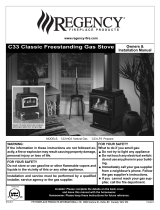 Regency Fireplace Products C33-LP3 User manual
Regency Fireplace Products C33-LP3 User manual
-
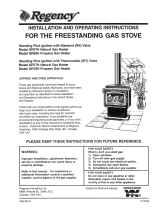 Regency Fireplace Products GR57 Owner's manual
Regency Fireplace Products GR57 Owner's manual
-
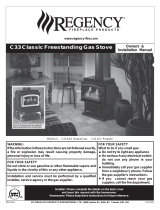 Regency Fireplace Products C33-NG2 User manual
Regency Fireplace Products C33-NG2 User manual
-
 Regency Fireplace Products Classic C34 Owner's manual
Regency Fireplace Products Classic C34 Owner's manual
-
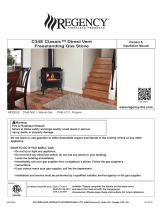 Regency Fireplace Products Classic C34E Owner's manual
Regency Fireplace Products Classic C34E Owner's manual
-
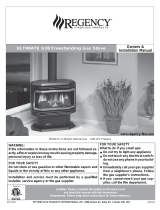 Regency Fireplace Products Ultimate U38-LP1 Owner's manual
Regency Fireplace Products Ultimate U38-LP1 Owner's manual
-
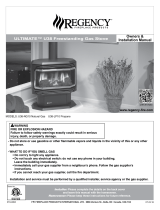 Regency Fireplace Products Ultimate U38 Owner's manual
Regency Fireplace Products Ultimate U38 Owner's manual
-
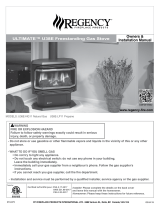 Regency Fireplace Products U38 Owner's manual
Regency Fireplace Products U38 Owner's manual
-
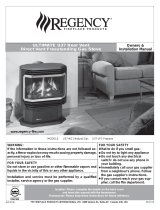 Regency Fireplace Products Ultimate U37 Owner's manual
Regency Fireplace Products Ultimate U37 Owner's manual
-
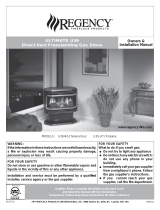 Regency Fireplace Products Ultimate U39 Owner's manual
Regency Fireplace Products Ultimate U39 Owner's manual
Other documents
-
Solt GGSPFS14TB User guide
-
Solt GGSPFS14TB Quick start guide
-
Camp Chef Pro 90X Quick start guide
-
Regency C33-NG2 User manual
-
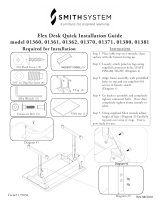 SMITH SYSTEM 179836 Assembly Instructions
SMITH SYSTEM 179836 Assembly Instructions
-
Hanover HAN032BLKCL Operating instructions
-
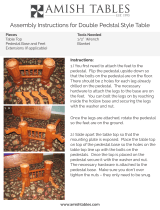 Amish Tables Double Pedstal Style Table Assembly Instructions
Amish Tables Double Pedstal Style Table Assembly Instructions
-
Regency U39-NG1 User manual
-
Regency U37-NG1 User manual
-
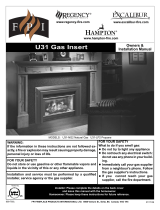 Recoton/Advent U31-NG2 User manual
Recoton/Advent U31-NG2 User manual








































